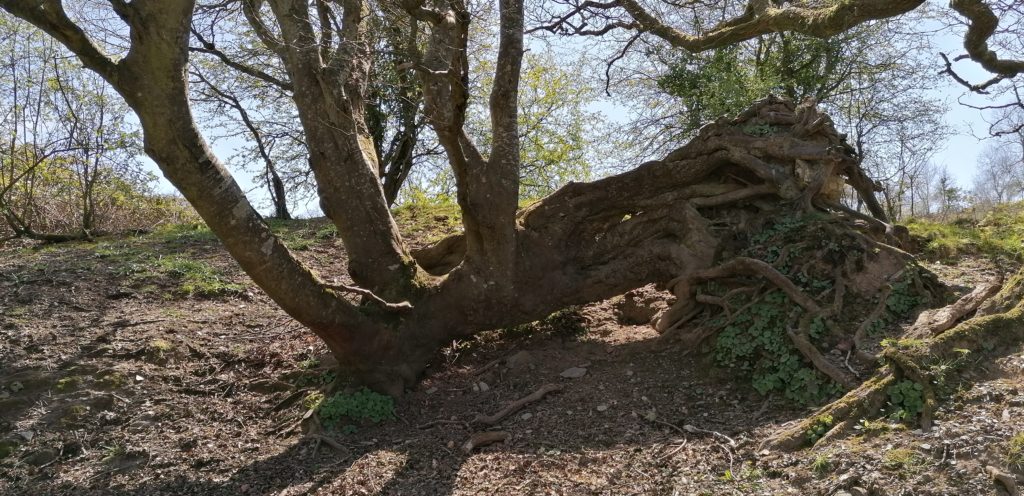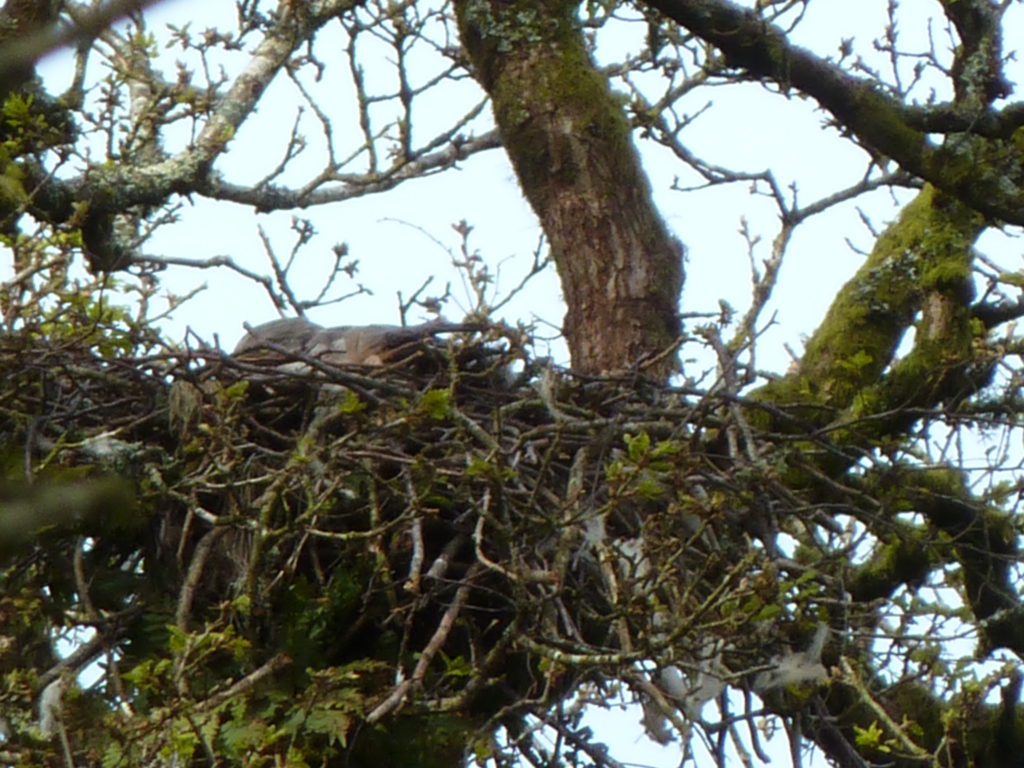Gaynor Funnell considers a local Sessile Oak, and the generations of Red Kite who have called it home.

It’s the first day of spring and the oak tree at the end of the track is starting to show signs of new life. The ivy that pulled its way up through the branches has remained a forest-green all winter so the oak never looks bare, even though the winter wind blew away the last of the bleached, marcescence of leaves that had been stubbornly clinging to its lower branches. The new leaves are a subtle, smooth shininess of copper-brown, which will evolve through mustard and a fizz of lime to a bright green in a few months. They will merge and blend with the canopy of ash, sycamore and hornbeam that help protect the lower growing hazel and birch and by high summer it will be difficult to tell where one tree ends and another begins.
It is said that the so-called ‘King of the Forest’ spends 300 years growing, 300 years resting and 300 years dying. Each tree is a habitat in itself, supporting hundreds of species of wildlife, including the woodpecker, tree-creeper, long-tailed tit, jay and squirrel. According to mythology, tree nymphs called hamadryades inhabit oak trees and were companions to Artemis, the Greek goddess of hunting. The druids believed the energy, power and strength of their god, Esus, were represented in the oak, and Herne the hunter and Gwyn-Ap-Nudd, the ruler of Annwn (the Welsh Otherworld) — whose hounds hunt souls across the sky — inhabit oak forests. Oak was one of the nine flowers that were used to create the goddess Blodeuwedd, whose name is also the ancient name for the owl she was turned into.
The oaks in this wood are Sessile oaks, not English. Sessile oaks are squat and broad and their branches are twisted and gnarled. They are the trees of fairy-tales and legends, dreams and nightmares. The bark of the tree is furrowed, wet-concrete grey, with a continuum of cracks, so rainwater can be funnelled to the ground from the top of the tree. It is rough and tough and cool to touch. Tannin in oaks was once used to tan leather, and its heavy, dense timber used for making furniture, building houses and ships. Jason’s ship the Argo was constructed from a sacred oak, as was King Arthur’s round table.
The usefulness of this tree is probably one of the reasons why there are few oaks left in this wood or nearby. Some have self-seeded in the sharp banks that edge their way to the stream and because there isn’t enough soil to support them when they get to a certain height, a few have fallen and have just been left — no machine here can get close enough to pull them out. Some have grown wide and twisted, the eddies and scurries of wind creating fantastical shapes. They are covered with moss and silver-green lichen, ferns waterfalling from their upper branches. Further down the valley, one lies with half of its roots in the air. There are slowly strangling a marbled quartz boulder, now at head-height, whilst the trunk has split into three, all growing. It resembles a washed-up sea creature from another time and place.
The oak at the bottom of the track is special. It’s not the tallest, the widest or the most symmetrical; in fact it’s quite uneven, since a large bough snapped like a twiglet two winters ago, and the gap it left hasn’t been filled yet. The reason it’s special is because, until last year, red kite have nested there.
Brought back from near extinction, they are a common sight here, especially during lambing when there is a plentiful supply of food, and when the farmers are making hay or silage. They cruise the airways, tails a-tilt, alongside screaming gulls and crows, waiting to see what the fields have to offer. They are opportunistic feeders, preferring carrion to live prey, although they reputedly kill small birds and mammals if nothing else is available. They will eat early-morning earthworms, although I’ve only seen buzzards do this. Kite have always struck me as inherently indolent birds, maybe because they soar slowly rather than flap, propelling themselves through the air with minimal effort, one deep wing-beat enabling them to travel the length of the field. They appear almost weightless, gliding and banking – changing direction without effort just by a flick of their tail – maybe because they only weigh about a kilo, which seems insubstantial for their size. They are often mobbed by corvids but rise above it with grace and disdain. They are a noble, aristocratic creature, which fill me with delight whenever I see them.

Unlike their sleek beauty, their nest is a mess. A collection of sticks-and-moss mess, added to every year. They also pick up anything they think might add to the general untidiness — pieces of plastic, baler twine (bright-blue, in this nest) a sock that dropped from the washing line. Wool left over from last year’s shearing has been used to soften this haphazardness, which is exaggerated when the adults start to feed their young — parts of a foraged lamb’s coat dangling like a bizarre out-of-season Christmas decoration.
The nest smells at peak feeding time — a miasma of decay permeates the woodland, stronger when you walk beneath the oak. This was especially noticeable one year when three young fledged, the adult birds on a never-ending journey to provide food for their raucous brood. They became used to me walking under the tree every day and I was privileged to see the young birds start to leave their nest. They would clumsily jump from branch to branch, spreading their wings experimentally, the closeness of the trees making it difficult for them to navigate a pathway. They screeched and hollered, still wanting food from their exhausted parents, leaping and hopping and flapping. Even though I knew they were big birds — their wingspan is at least the size of me — I hadn’t appreciated how big they were until I was able to be so close to them. Five red kite in close proximity made me and this woodland seem small.
Their colouring is quite beautiful and distinct — a fox-red body feathering to blackened wing tips, with white patches when seen from underneath and a frosted-silver head streaked with ink. Their eyes, feet and hooked beak are all yellow, the beak seemingly small compared to the size of the bird.
Within five days they were gone. The wood seemed quiet after the excitement. You were once again able to hear the blackbird, the wren, the wood-pigeon. The oak stretched its branches around the empty nest and leaves snuck into the once-full corners. The lambswool stretched lower and lower after the rain and became streaked with green rather than rust-brown. In the autumn, I found fragments of bone, and bizarrely, a lamb’s tail complete with an orange docking ring. Occasionally, a kite glided overhead and tilted its wings, just as a pilot would gesture.
*
Gaynor Funnell is studying for an MA in Creative Writing at Swansea University. You can follow her on Twitter here.